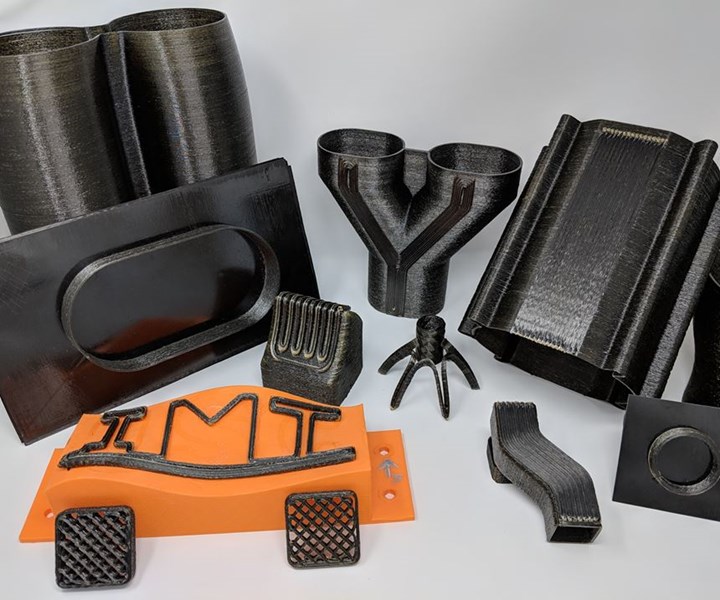CW's top 10 articles of 2019
It’s time to reflect upon the trends and innovations seen in the composites industry over the past year and contemplate what might be ahead in 2020.

From CW’s #1 story of 2019, on continuous-fiber 3D printing
Source | McNair Center
Happy New Year! As we wrap up 2019, it’s a time to reflect upon the trends and innovations seen in the composites industry over the past year and contemplate what might be ahead in 2020. To that end, here’s a list of the most viewed articles on the ÂÌñÏ×ÆÞ website in 2019.
- Moving continuous-fiber 3D printing into production — This early 2019 article looked at emerging production applications for 3D printing with continuous fiber reinforcement. Numerous announcements during the year have indicated the trend continues to grow.
- What does the future hold for Bombardier Belfast? — Spirit AeroSystems Holdings Inc. (Wichita, Kan., U.S.) announced in October 2019 a definitive agreement to acquire select assets of Bombardier (Montreal, Canada) aerostructures and aftermarket services businesses in Belfast, Northern Ireland; Casablanca, Morocco; and Dallas, Texas, U.S. An earlier blog post by CW Editor Jeff Sloan (posted in May 2019, when it was announced that Bombardier Belfast was for sale) speculated about what the sale of the fabricator might mean for the future of infusion in large aerostructures.
- Thermoplastic primary aerostructures take another step forward — Employing new manufacturing techniques and the design freedom they create, GKN Fokker (Hoogeveen, Netherlands) joined forces with Gulfstream (Savannah, Ga., U.S.) in 2019 to assess thermoplastic composites for primary aircraft structures.
- Accelerating thermoplastic composites in aerospace — Following up a series of articles in 2018 on TPC tapes, in-situ consolidation and welding and two webinars in 2019 on TPCs in automotive applications and TPC developments for aerospace, CW senior editor Ginger Gardiner reported on​â¶Ä‹â¶Ä‹â¶Ä‹&²Ô²ú²õ±è;ATC Manufacturing (Post Falls, Idaho, U.S.). The company manufactures millions of thermoplastic composite parts per year, and is investing for future growth.
- Thermoplastic door a first for automotive composites — Prior to her retirement in early 2019, former CW senior editor Sara Black delivered a few more great articles (we miss you Sara!). Here she covers a team of automotive researchers engaged in a four-year project with goals of building a lighter, 100% recyclable, carbon fiber-reinforced thermoplastic door.
- The still-promised potential of basalt fiber composites — Although the long-anticipated market surge in basalt fiber-reinforced polymer composites remains largely in the future, basalt fiber manufacturers are making headway over the technical and market hurdles toward large-scale application.
- Withstanding fire without the weight&²Ô²ú²õ±è;&³¾»å²¹²õ³ó;​â¶Ä‹â¶Ä‹â¶Ä‹â¶Ä‹â¶Ä‹â¶Ä‹ New composites meet stringent fire requirements while lightweighting ships, rail cars and battery boxes for electric cars and planes.
- 3D printing continuous fiber on the desktop&²Ô²ú²õ±è;&³¾»å²¹²õ³ó;​â¶Ä‹â¶Ä‹â¶Ä‹â¶Ä‹â¶Ä‹â¶Ä‹ As mentioned earlier in this post, 3D printing with continuous fiber is a growing trend. In November of 2019, additive manufacturing technology company Desktop Metal (Burlington, Mass., U.S.) expanded its offerings to include high-performance composites, unveiling what it says is the world’s first true continuous fiber desktop printer.​​​​​​​
- Large, high-volume, infused composite structures on the aerospace horizon&²Ô²ú²õ±è;&³¾»å²¹²õ³ó;​â¶Ä‹â¶Ä‹â¶Ä‹â¶Ä‹â¶Ä‹â¶Ä‹ As part of a special issue on next-gen aerospace released by CW in June of 2019, CW editor Jeff Sloan offered insight into the role infused carbon fiber composite structures might play for next-generation, single-aisle aircraft.
- The state of recycled carbon fiber&²Ô²ú²õ±è;&³¾»å²¹²õ³ó;​â¶Ä‹â¶Ä‹â¶Ä‹â¶Ä‹â¶Ä‹â¶Ä‹ While the technology to recycle carbon fiber composites has existed for several years and is capable of yielding a product with mechanical properties very near that of virgin material, the composites recycling industry is relatively young and is still in the early stages of developing markets for the materials it produces from recyclate. This article by CW senior editor Scott Francis examines the growing rCF industry.
Thank you for reading CW, and have a great 2020.
Related Content
Composites end markets: Sports and recreation (2025)
The use of composite materials in high-performance sporting goods continues to grow, with new advancements including thermoplastic and sustainability-focused materials and automated processes.
Read MorePartners recycle A350 composite production waste into adjustable-length rods for MFFD
Herone, Spiral RTC, Teijin Carbon Europe and Collins Aerospace Almere recycle A350 thermoplastic composite clips/cleats waste into rods for the all-thermoplastic composite Multifunctional Fuselage Demonstrator’s crown.
Read MoreAll-recycled, needle-punched nonwoven CFRP slashes carbon footprint of Formula 2 seat
Dallara and Tenowo collaborate to produce a race-ready Formula 2 seat using recycled carbon fiber, reducing CO2 emissions by 97.5% compared to virgin materials.
Read MoreCorebon induction heating
This sidebar to CW’s August 2024 feature article reviews this technology for more efficient composites manufacturing and why it aligns with Koridion active core molding.
Read MoreRead Next
Cutting 100 pounds, certification time for the X-59 nose cone
Swift Engineering used HyperX software to remove 100 pounds from 38-foot graphite/epoxy cored nose cone for X-59 supersonic aircraft.
Read MoreScaling up, optimizing the flax fiber composite camper
Greenlander’s Sherpa RV cab, which is largely constructed from flax fiber/bio-epoxy sandwich panels, nears commercial production readiness and next-generation scale-up.
Read MoreNext-gen fan blades: Hybrid twin RTM, printed sensors, laser shock disassembly
MORPHO project demonstrates blade with 20% faster RTM cure cycle, uses AI-based monitoring for improved maintenance/life cycle management and proves laser shock disassembly for recycling.
Read More









